
This is only the beginning, I had some material on Clarens and decided to write up what I have. But this still needs another visit to pick up on other places of interest.
Clarens
A small town in the Free State, the nearest bigger towns are Bethlehem and Harrismith. It's geo-position: 28.5149°S, 28.4212°E and 1817m a.m.s.l. According to Wikipedia it had 751 residents in 2011.
History
The town was first established in 1912. Whether by design or by accident the town started attracting artists and it became a bit of a art centre with art galleries and art shops frequenting the town. Making it a tourist attraction, and tourists are attracted to the place At times parking is difficult to fins in and near the town centre. If I remember correctly the process of making it into a tourism centre started in the 1970's. Possibly catalysed by the establishment of the Golden Gate National Park.
Basotho war memorial
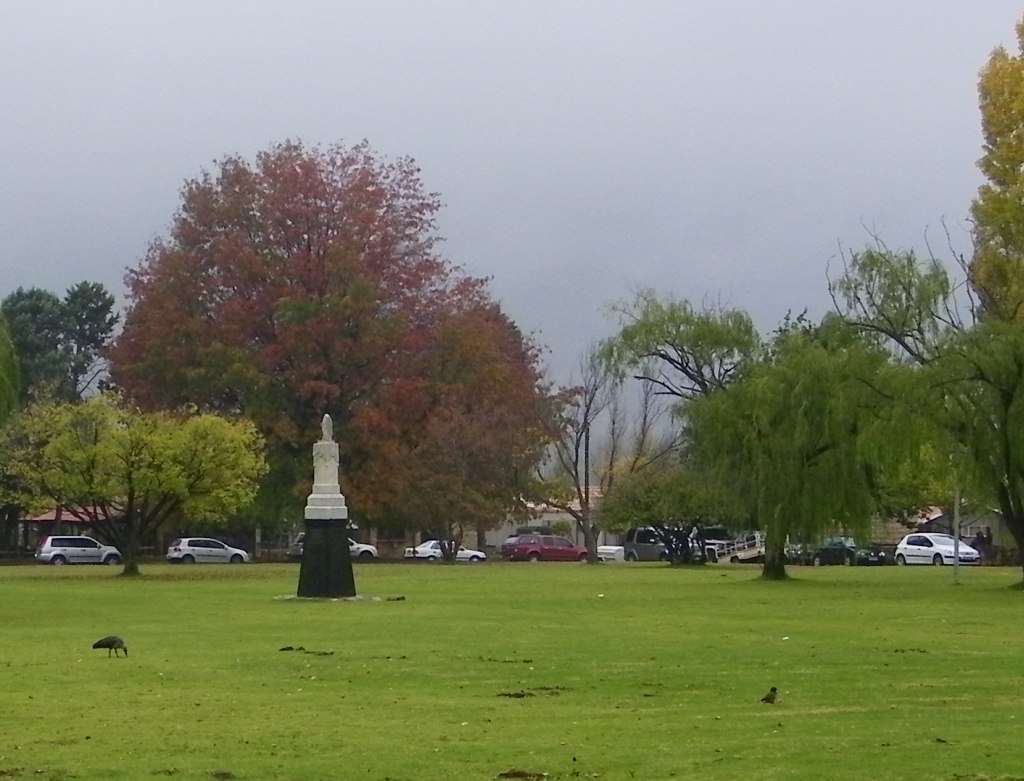 There is a monument to the Basuto War in the central square. The inscription reads: Slag van Naauwpoort; 29 Sept 1865; opgericht door; de J.Vereenigings; en het publiek; onthul 16 Des.1895 te Ararat; deur Komdt. H.J.Bruwer and on the oposit side: heronthul 9 Nov.1962; deur staatspresident; C.R.Swaart; tydens Clarens; se goue jubelium; in dankbare nageslag; bring hulde. Translated into English: Battle of Naaupoort, 29 September 1865; erected by the J.Society; and the public; unveiled 16 December 1895 at Ararat; by Kommandant HJ Bruwer and on the other side: re-unveiled on 9 November 1962; by state presidentC.R.Swart; during the golden jubilee of Clarence; praise by the thankful dependents. There are some names listed: Michel Horn, Jan Minnaar, Edzard Roussaw, Pieter de Beer and Gert Broodryk. These are the people from the commando who died here.
The background to this event, it refers to the 2nd Basuto War of 1865. There were three Basuto wars altogether, the 1st 1858, the 2nd 1865 and the 3rd 1867-68. In the second Basuto war the Transvaalers came to the assistance of the Free Staters. Here it was a commando of about 300 burghers under the commandant Paul Kruger (the future president of the Transvaal Republic), which was moving from Harrismith to clear the area of the Basuto's. The commando felt very much at ease when they set up camp for the night at Naauwpoort. No defensive precautions were taken, this turned out to be a mistake. In the early hours of the morning, it was still dark, the lager was attacked by the Basuto. Five burghers were killed and 10 wounded. Two days later burghers from the surrounding areas arrived to help drive the Basuto's down the hill.
There is a monument to the Basuto War in the central square. The inscription reads: Slag van Naauwpoort; 29 Sept 1865; opgericht door; de J.Vereenigings; en het publiek; onthul 16 Des.1895 te Ararat; deur Komdt. H.J.Bruwer and on the oposit side: heronthul 9 Nov.1962; deur staatspresident; C.R.Swaart; tydens Clarens; se goue jubelium; in dankbare nageslag; bring hulde. Translated into English: Battle of Naaupoort, 29 September 1865; erected by the J.Society; and the public; unveiled 16 December 1895 at Ararat; by Kommandant HJ Bruwer and on the other side: re-unveiled on 9 November 1962; by state presidentC.R.Swart; during the golden jubilee of Clarence; praise by the thankful dependents. There are some names listed: Michel Horn, Jan Minnaar, Edzard Roussaw, Pieter de Beer and Gert Broodryk. These are the people from the commando who died here.
The background to this event, it refers to the 2nd Basuto War of 1865. There were three Basuto wars altogether, the 1st 1858, the 2nd 1865 and the 3rd 1867-68. In the second Basuto war the Transvaalers came to the assistance of the Free Staters. Here it was a commando of about 300 burghers under the commandant Paul Kruger (the future president of the Transvaal Republic), which was moving from Harrismith to clear the area of the Basuto's. The commando felt very much at ease when they set up camp for the night at Naauwpoort. No defensive precautions were taken, this turned out to be a mistake. In the early hours of the morning, it was still dark, the lager was attacked by the Basuto. Five burghers were killed and 10 wounded. Two days later burghers from the surrounding areas arrived to help drive the Basuto's down the hill.
Naauwpoort is the gorge through which the road from the north comes into town.
Another piece of information obtained from the monument is that it was initially erected at Ararat and was moved and modified onto president square in 1962. The bottom, the dark part, would be new.
Surrender Hill
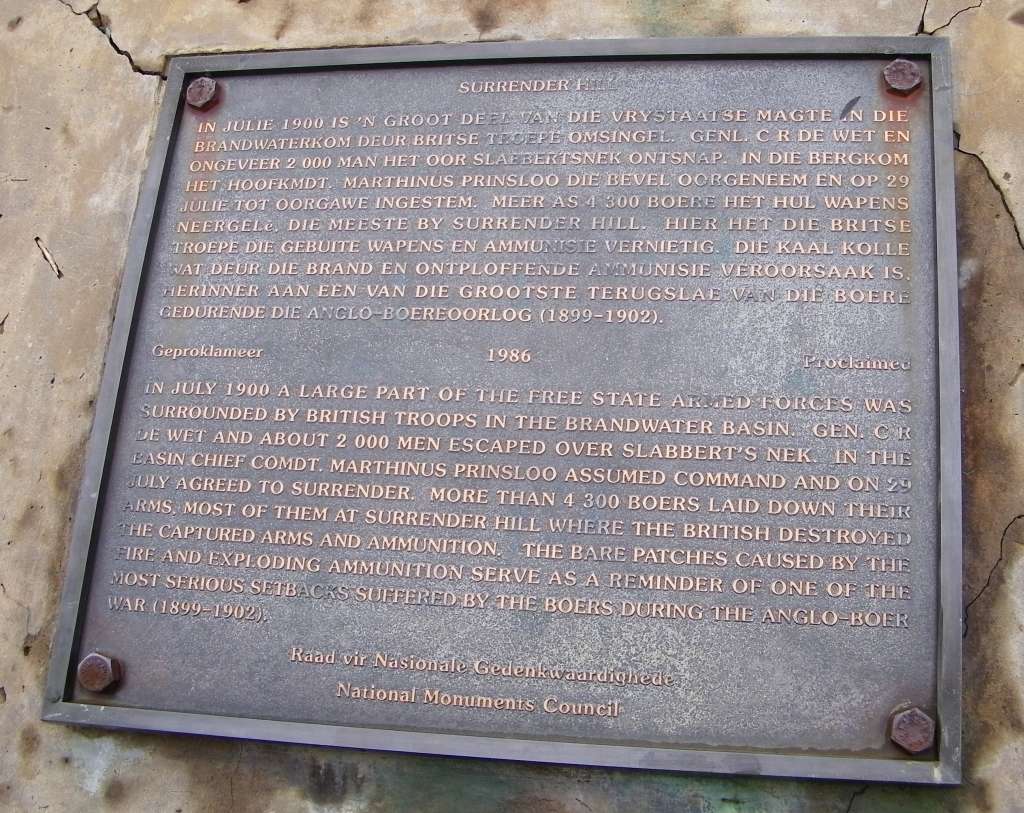 In July 1900 a large part of the Free State armed forces were surrounded by British troops in the Brandwater Basin. Gen CR De Wet and about 2 000 men escaped over Slabbert's Nek. In the basin, Chief Comdt Marthinus Prinsloo assumed command and on 31 July agreed to surrender. More than 4300 Boers laid down their arms. Most of them at Surrender Hill, where the Boers destroyed their weapons and ammunition. The bare patches caused by the fire and exploding ammunition serve as a reminder of one of the most serious setbacks suffered by the Boers during the Anglo-Boer War (1899-1902).
In July 1900 a large part of the Free State armed forces were surrounded by British troops in the Brandwater Basin. Gen CR De Wet and about 2 000 men escaped over Slabbert's Nek. In the basin, Chief Comdt Marthinus Prinsloo assumed command and on 31 July agreed to surrender. More than 4300 Boers laid down their arms. Most of them at Surrender Hill, where the Boers destroyed their weapons and ammunition. The bare patches caused by the fire and exploding ammunition serve as a reminder of one of the most serious setbacks suffered by the Boers during the Anglo-Boer War (1899-1902).
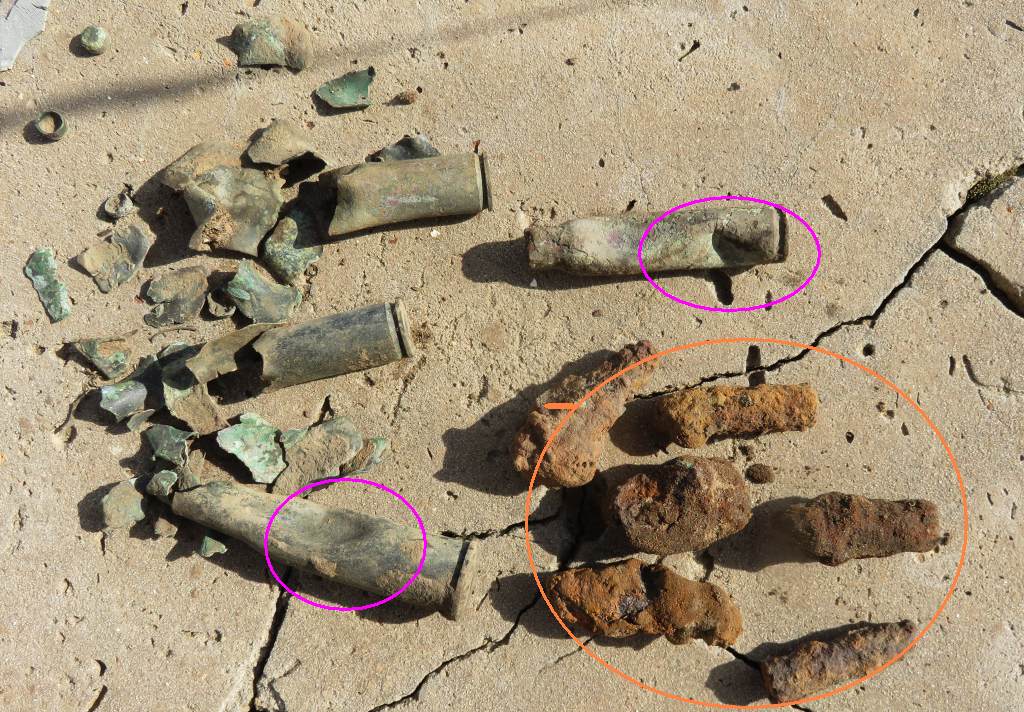 A monument was erected at the place of surrender, it used to have a plaque, but that has been removed, I guess by scrap metal collectors. Fortunately I do have a picture of the plaque when it was still in position. The exif file states the picture was taken on the 27 April 2010, thus the plaque was removed/stolen after that.
A monument was erected at the place of surrender, it used to have a plaque, but that has been removed, I guess by scrap metal collectors. Fortunately I do have a picture of the plaque when it was still in position. The exif file states the picture was taken on the 27 April 2010, thus the plaque was removed/stolen after that.
Remnants from that scene of destruction can still be found around the monument by a keen-eyed searcher. The picture on the right shows what was collected during s recent visit (Feb 2021). Of interest are the pieces of rusty iron (orange ring) and the dented cartridges (purple rings). The rusty iron can be explained by the fact that the surrendering Boers brought their wagons loaded with ammunition to this place and burned them.
The dented ammunition I cannot figure out with any measure of certainty. My proposal is that the Boers did this to disable the cartridges so that they cannot be used by the enemy.
Church
 This beauty full church was designed by Gerard Moerdijk and built in 1940. A special feature is a stone recovered from the foundation of the second Voortrekker church in Natal incorporated in the portal. This was the church on Mount Howell between the Groot and the Klein Tugela river near the present Winterton, it had been built in 1852 and was demolished in 1874.
This beauty full church was designed by Gerard Moerdijk and built in 1940. A special feature is a stone recovered from the foundation of the second Voortrekker church in Natal incorporated in the portal. This was the church on Mount Howell between the Groot and the Klein Tugela river near the present Winterton, it had been built in 1852 and was demolished in 1874.
During a recent visit (March 2021) I submitted the portal of the church to a close inspection, but couldn't establish which of the stones came from the Winterton church. The keystone in the top of the arch has a slightly different colour, as well as the stone to the left of it. Could those be the stone, could anybody from Clarens please inform me?
The congregation was first established by ceding from the congregation of Bethlehem in 1920.
Ash river outfall
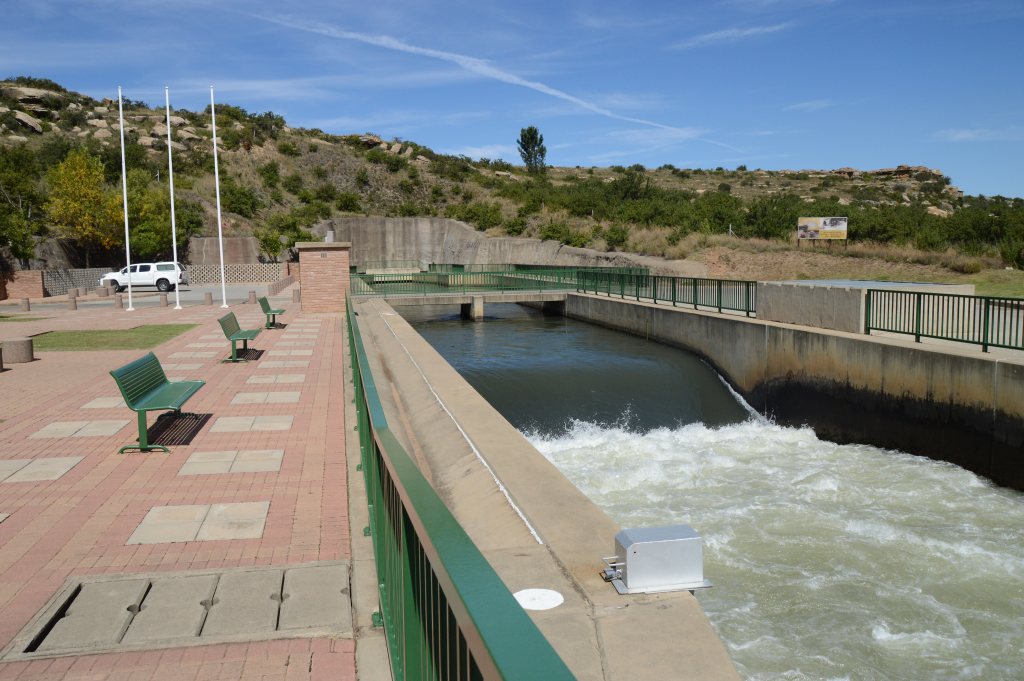 To see the full flow of water coming out from the tunnel is an impressive sight. It is water coming over from Lesotho's Katse dam. The dam is part of the Lesotho Highland water scheme. It was mainly designed to take water over the mountain to feed into the Vaal Dam system supplying water to the areas around Johannesburg. The water is transferred through a tunnel of 5m diameter which exits to the north of Clarence into the Ash River. From there it enters the Liebenberg spruit and than into the Wilge river near Frankfort.
To see the full flow of water coming out from the tunnel is an impressive sight. It is water coming over from Lesotho's Katse dam. The dam is part of the Lesotho Highland water scheme. It was mainly designed to take water over the mountain to feed into the Vaal Dam system supplying water to the areas around Johannesburg. The water is transferred through a tunnel of 5m diameter which exits to the north of Clarence into the Ash River. From there it enters the Liebenberg spruit and than into the Wilge river near Frankfort.
van Reenen grave yard

 On the way to the Golden Gate National Park, coming from Clarens, just after passing the gate there is a small enclosed grave yard of the van Reenen family. Apart from the beautyfull setting there are two graves of special interest. It's those of Wilcocks and de la Harpe. In the area known as the two lovers, what led to their early death?
On the way to the Golden Gate National Park, coming from Clarens, just after passing the gate there is a small enclosed grave yard of the van Reenen family. Apart from the beautyfull setting there are two graves of special interest. It's those of Wilcocks and de la Harpe. In the area known as the two lovers, what led to their early death?
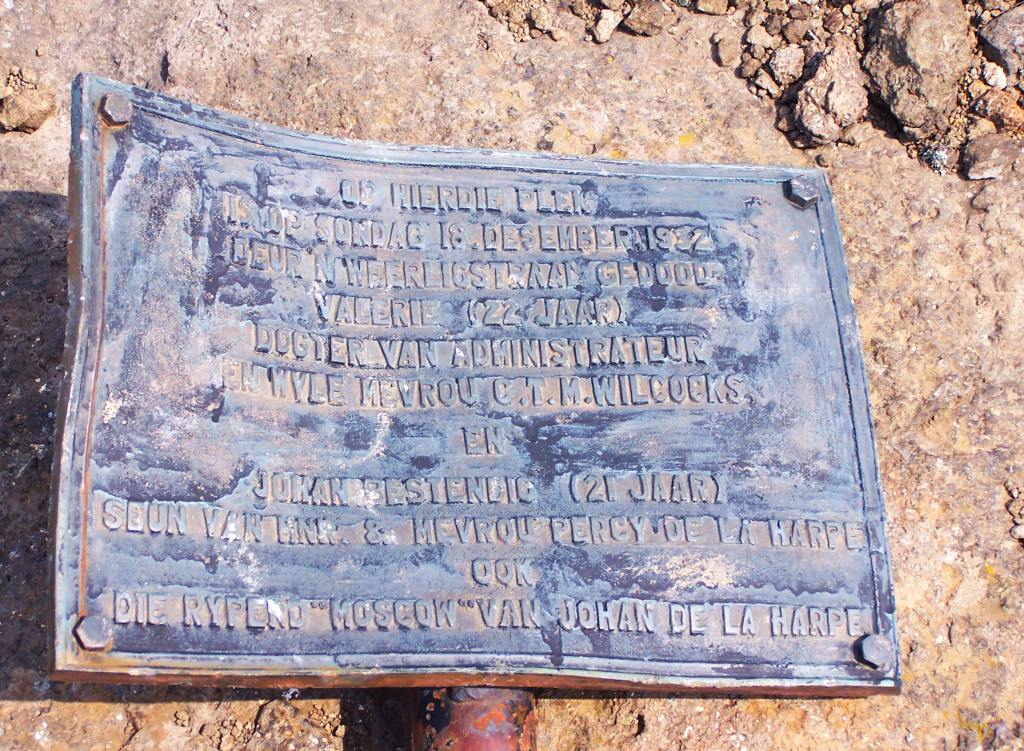 Further up along the mountain when one hikes from the chain ladder up to Mt aux Sources on the right shoulder is a plaque, translated the sign reads: At this place a lightning strike on Sunday 18 December 1932 killed Valerie (22 years), daughter of the administrator and late wife C.T.M. Wilcocks, and Johan Bestendig (21 years) son of Mr. And Mrs. Percy de la Harpe, also the riding horse ‘Moscow’ of Johan de la Harpe.
CTM Wilcocks was the administrator of the Free State from 1929 to 1939. The bodies of the deceased were taken to and buried at the Golden Gate.
Further up along the mountain when one hikes from the chain ladder up to Mt aux Sources on the right shoulder is a plaque, translated the sign reads: At this place a lightning strike on Sunday 18 December 1932 killed Valerie (22 years), daughter of the administrator and late wife C.T.M. Wilcocks, and Johan Bestendig (21 years) son of Mr. And Mrs. Percy de la Harpe, also the riding horse ‘Moscow’ of Johan de la Harpe.
CTM Wilcocks was the administrator of the Free State from 1929 to 1939. The bodies of the deceased were taken to and buried at the Golden Gate.
Golden Gate National Park
References
Ref 1.: Standard Encyclopedia of Southern Africa, Nasou Limited, 1974
Ref 2.: J Nienaber, CJP le Roux, Vrystaat-Fokus, CUM Boeke, 1982
Ref 3.: Article by Siska Martin, 'Plaat vir gelieftes op Mount-aux-Sources';, Volksblad, 23-02-2018